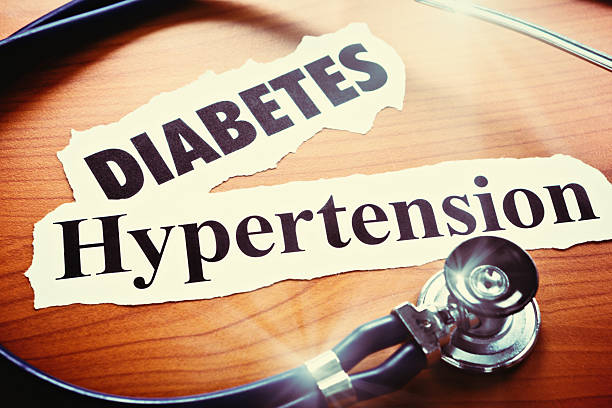The #1 Rated Blood Sugar Formula
The link between diabetes and hypertension

The same is true if the blood sugar goes too low; the catecholamine response is the first thing that the body uses to compensate, and this will raise blood pressure in the aftermath. This is how low blood sugar or low blood pressure can cause the other to go high.
While diabetes and hypertension do often go hand-in-hand, having one condition does not mean that you will get the other. You can take steps to manage both conditions and the complications they can cause. In some cases, the small changes you make can even prevent or reverse the conditions.
High blood pressure, or hypertension, often occurs alongside diabetes and obesity. Together, these conditions fall under the umbrella of metabolic syndrome. People with metabolic syndrome are at an increased risk for cardiovascular diseases.
Identifying hypertension and diabetes
Some relatively simple tests are available to help a person identify whether they have diabetes or hypertension.Identifying hypertension
The American Heart Association (AHA) states that most people who have hypertension do not experience any symptoms. People usually discover that they have hypertension following a routine blood pressure check. A blood pressure reading will display numbers representing two different types of blood pressure: systolic and diastolic.- Systolic: This number appears at the top. It represents the maximum pressure the heart exerts when beating.
- Diastolic: This number appears at the bottom. It represents the amount of pressure in the arteries between heartbeats.
- Normal: Systolic is below 120 and diastolic is below 80.
- Elevated: Systolic is 120–129 and diastolic is below 80.
- Hypertension stage 1: Systolic is 130–139 or diastolic is 80–89.
- Hypertension stage 2: Systolic is 140 or higher, or diastolic is 90 or higher.
- Hypertensive crisis: Systolic is higher than 180 or diastolic is above 120.
Identifying diabetes
According to the American Diabetes Association (ADA), not everyone with diabetes will experience symptoms of the disease. If symptoms of high blood glucose levels do appear, they may include:- excessive thirst
- excessive hunger
- frequent need to urinate
- extreme fatigue
- blurred vision
- delayed wound healing
- urinary tract infections (UTIs)
- thrush
- upper respiratory tract infections
- Normal: This is less than 100 milligrams per deciliter (mg/dl).
- Prediabetes: This is between 100–125 mg/dl.
- Diabetes: This is a reading of 126 mg/dl or above.
Types of diabetes and their symptoms
There are three kinds of diabetes, all of which have different causes:Type 1 diabetes
Type 1 diabetes is an autoimmune disorder in which the body mistakenly attacks cells in the pancreas that produce insulin. The disease tends to appear during childhood or adolescence, though it can occur later in life.Type 2 diabetes
Type 2 diabetes occurs as a result of insulin resistance. This is where body cells lose their ability to respond to insulin. The pancreas tries to compensate by producing more insulin, but the process is not sustainable. Current guidelines recommend diabetes screening for everyone ages 45 years or above, and anyone younger who has risk factors for the disease. Early diagnosis and treatment can help slow or even reverse the disease, reducing the risk of complications.Gestational diabetes
Gestational diabetes occurs only in pregnancy, though around 50% of females with this form go on to develop type 2 diabetes. If a routine screening shows high blood sugar levels during pregnancy, a doctor will monitor the person’s condition until a few weeks after delivery. In most cases, blood sugar levels return to normal immediately after delivery.What is the link between diabetes and hypertension?
A 2021 article notes that diabetes and hypertension often occur together and may share some common causes. These include:- sedentary lifestyle with excessive calorie intake
- obesity
- inflammation
- oxidative stress
- insulin resistance
Can diabetes cause hypertension?
A person with diabetes either does not have enough insulin to process glucose or their insulin does not work effectively. Insulin is the hormone that enables the body to process glucose from food and use it as energy. When a person has insulin problems, glucose cannot enter their cells to provide energy, so it accumulates in the bloodstream instead. High blood glucose levels can cause widespread damage to tissues and organs, including those that play a key role in maintaining healthy blood pressure. For example, damage to the blood vessels and kidneys can cause blood pressure to rise.Do people with diabetes have higher rates of hypertension?
The Centers for Disease Control and Prevention (CDC) states that around 47% of adults in the United States have hypertension or are taking medication to manage the condition. By comparison, the ADA states that 2 in 3 people with diabetes either report hypertension or are taking prescription medication to lower their blood pressure. The above statistics suggest that people with diabetes have higher rates of hypertension compared to the general population.Can hypertension cause diabetes?
According to a 2018 article, people with high blood pressure usually have insulin resistance and have an increased risk of developing diabetes compared to those with typical blood pressure. This may be due to bodily processes that link both conditions, such as:- inflammation
- oxidative stress
- activation of the immune system
- disease or thickening of the blood vessels
- obesity
Diabetes and hypertension complications
The combined impact of diabetes and high blood pressure can increase the risk of cardiovascular disease, kidney disease, and other health issues. Without treatment, diabetes and high blood pressure may lead to serious complications, such as:- eye problems
- kidney failure
- heart attack
- stroke
Risk factors
Hypertension and type 2 diabetes share similar risk factors. These include:
- being overweight or having obesity
- having a sedentary lifestyle
- following an unhealthy diet
- experiencing chronic stress
- having poor sleep habits
- smoking tobacco
- being exposed to air pollution
- a diet high in sodium
- low levels of potassium
- high alcohol consumption
Prevention
The following lifestyle factors are crucial for managing both blood glucose levels and blood pressure.Maintaining a healthy weight
For people with excess weight, losing even a little can help reduce the risk of both high blood pressure and diabetes. The National Heart, Lung, and Blood Institute (NHLBI) notes that a 3–5% loss of body weight can improve blood pressure readings. Similarly, the CDC notes that a 5–7% loss of body weight can help stop prediabetes from developing into diabetes. This equates to a loss of 10–14 pounds for a person who weighs 200 pounds.Being physically active
Regular physical activity can lower blood pressure and help manage blood glucose levels, besides providing other health benefits. Current CDC guidelines recommend a minimum of 150 minutes of moderate-intensity aerobic exercise each week or 75 minutes of vigorous-intensity exercise each week. Moderate exercise includes brisk walking and swimming. People should also consider doing muscle strengthening exercises. People who have not been active for a while can speak with their doctor for advice on a suitable exercise plan.Following a healthy diet
People with diabetes and hypertension can ask their doctor for information and advice on an appropriate diet plan. Doctors often recommend the Dietary Approaches to Stop Hypertension (DASH) diet for managing blood pressure and overall well-being. This typically includes:- eating plenty of fresh fruits and vegetables
- focusing on high fiber foods, including whole grains
- limiting added salt and sugar
- avoiding or limiting unhealthy fats, such as trans fats and animal fats
Limiting alcohol consumption
High consumption of alcohol can increase the risk of the following:- excess calorie intake
- weight gain and diabetes
- thickening of the artery walls
- raised blood pressure
- one 12-ounce beer
- one 4-ounce glass of wine
- one 1.5-ounce serving of 80-proof spirits
- one 1-ounce serving of 100-proof spirits
Avoiding or quitting smoking
Tobacco smoking causes blood vessels to constrict, resulting in a temporary increase in blood pressure. It also increases the buildup of plaque within the arteries, which can lead to increases in blood pressure over time. Tobacco smoking can also increase the risk of type 2 diabetes. Smokers with diabetes have a higher risk of developing serious complications, including:- heart or kidney disease
- retinopathy, which is an eye disease that may lead to blindness
- poor blood flow, making infection and the risk of foot or leg amputation more likely
- peripheral neuropathy, which can cause nerve pain in the arms and legs
Treatment with medication
In addition to lifestyle measures, a doctor may prescribe medications to help manage diabetes and hypertension.Treatments for diabetes
The treatment for diabetes will depend on the type a person has. For type 1 diabetes, a person will need to use insulin. They may also require medications to manage any complications, such as hypertension. For type 2 diabetes, some people will need to use insulin. Others may use non-insulin medication, such as metformin, to help reduce blood pressure. People may also require medications to manage any complications, such as hypertension. Current guidelines also recommend using one of the following if a person with type 2 diabetes has a high risk of atherosclerotic cardiovascular disease, diabetes-related kidney disease, or both:- sodium-glucose cotransporter 2 inhibitors (SGLT2)
- glucagon-like peptide 1 (GLP-1) receptor agonists
Treatments for hypertension
Numerous medications are available to help manage hypertension. A doctor may prescribe a combination of medications. Some examples include:- Angiotensin-converting enzyme (ACE) inhibitors: ACE inhibitors reduce production of the hormone “angiotensin.” This allows the blood vessels to relax and dilate, thereby lowering blood pressure.
- Angiotensin II receptor blockers: These medications block the effects of angiotensin, which is a chemical that causes the arteries to narrow. Without angiotensin, the blood vessels remain open, thereby reducing blood pressure.
- Beta-blockers: These medications cause the following effects on the heart, which help to lower blood pressure:
- reducing heart rate
- reducing the heart’s workload
- reducing the heart’s output of blood
- Calcium channel blockers: Calcium causes the smooth muscles of the heart and arteries to contract. Calcium channel blockers prevent this action, resulting in less forceful heart contractions and a relaxation of the blood vessels. Both result in a reduction in blood pressure.
- Diuretics: These medications help the body remove excess sodium and water, which reduces blood volume and helps manage blood pressure.
- Vasodilators: These are medications that cause the muscular walls of the blood vessels to relax and dilate. This allows blood to flow through more easily, thereby reducing blood pressure.
Outlook
Hypertension and diabetes often occur together and share multiple risk factors and causes. Having one condition increases a person’s likelihood of developing the other. Detecting and treating hypertension and diabetes promptly helps to prevent serious complications. Lifestyle adjustments can help manage blood pressure and blood glucose levels. Some people may also require medications. People can discuss a suitable treatment plan with their healthcare professional. It is important to attend regular checkups to make sure blood pressure and blood glucose are within safe levels.diabetes and high blood pressureDiabetes and hypertension complicationsGood Practice for HypertensionIdentifying hypertension and diabetesLifestyle Modifications to Reduce Blood Pressurelink between diabetes and hypertensionrisk factor of diabetes and high blood pressuresign and symptoms of high blood pressureSymptoms of DiabetesTypes of diabetes and their symptoms






